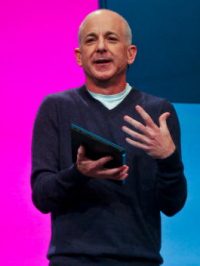Sinofsky's departure from Microsoft: Politics or products to blame?

In the hours following word of Windows President Steven Sinofsky's immediate departure from the company, speculation swirled as to the "real" reasons for the move.

A number of folks on Twitter and email opined that they believed supposed poor early sales of Windows 8 and/or the Surface RT were to blame. I'm betting many Microsoft watchers on Wall Street will react similarly. Windows 8 launched commercially just about three weeks ago; it's too soon to judge if the latest Windows release and the Microsoft Surface tablet will be deemed successes or failures. And still months before anyone will be sacrificed if internal projections are unmet.
I give more credence to the politics theory. My CNET colleague Jay Greene wrote a profile of Sinofsky recently, in which he noted the Windows chief had sparred with a number of senior Microsoft managers, and even CEO Steve Ballmer.
I don't see Monday's news as signifying any kind of change in short-term Windows product strategy. I'm not anticipating a return of the Start Button or a return of Silverlight. I'll be surprised if the new Windows regime, currently headed by engineering chief Julie Larson-Green and CFO/CMO Tammi Reller doesn't continue to follow the current preset course, with "Blue," the first Windows 8 successor, hitting by mid-2013, followed by Windows 9 by 2014 or so. (There likely will be cross-divisional strategy changes coming in the not-so-distant future, but more on that in a bit.)
It's also worth noting that the timing of the Sinofsky departure announcement isn't as unusual or alarming as some are claiming. Windows 8 engineering is finished; the product is now in the hands of the marketers, deployers and licensors.
Once products ship and new planning/development cycles begin at Microsoft, management changes often happen. Plus, at the end of each calendar year (and also many times at the mid-year point), Microsoft often instigates reorgs, sometimes within single business units, and other times across business units.
There was a clue in Microsoft's most recent proxy statement of a possible coming reorg. Read this excerpt from my write-up:
Next year, Microsoft plans to measure things a bit differently, with less of an emphasis on the performance of Microsoft's five individualized business groups, the Proxy notes. "For 2013, the focus of awards under the Plan will shift from performance ofseparate business groups to a combination of business group and company-wide performance. This shift aligns with our overall business strategy to provide integrated product and service offerings, and this requires deeper cross-organization collaboration."
Remember that word: collaboration. It can mean anything from being willing to use other teams' code, to not standing in the way when another division launches its product on a competitive platform.
Sinofsky is known inside and outside the company as a guy who got things done and done his way. Rumors regularly reappeared about Sinofsky angling to take over more business units. And until recently, it seemed like Microsoft's own senior leadership team, as well as Ballmer himself, had capitulated, allowing Sinofsky to make whatever management decisions he deemed fit. Those who disagreed left or were shown the door (and probably won't be back, though never say never).
But more recently, something seemingly changed, including the rhetoric. Ballmer's note to the troops about Sinofsky's departure emphasized the ability of his successor Larson-Green's "proven ability to effectively collaborate and drive a cross company agenda." I smell a reorg....
If the "doesn't play well with others" reason really is a big factor in Sinofsky's departure, who are the "others" who pushed back? Here are the remaining heads of Microsoft's biggest teams:
- Server and Tools: Satya Nadella
- Online Services: Qi Lu
- Business Division: Kurt DelBene
- Entertainment & Devices: Don Mattrick
- Windows Phone: Terry Myerson
- Skype: Tony Bates
- Chief Operating Officer: Kevin Turner
- Research and Strategy: Craig Mundie
Another question: Who is going to be the new President of Windows? Neither Larson-Green nor Reller was awarded the President's title. Who will be placed in that role, either from inside or outside the company?
In hindsight, some recent puzzling events now make more sense. Why was Sinofsky sitting in the audience prior to the start of the first keynote at Microsoft's late October Build 2012 conference -- just before Ballmer surprisingly took to the stage to demo Windows 8. (Not something Ballmer typically had done, but he did it quite well.) Why was Sinofsky's performance at the October 26 Windows 8 launch so atypically rote and lackluster? Why were Sinofsky's scheduled press interviews just before the Windows 8 launch cancelled on very short notice? (I wasn't on the short -- or the long -- list to get one, but I heard from others this was the case.)
Microsoft has a CEO who, for better or for worse depending on your perspective, isn't going anywhere for a while, unless the board says so. Ballmer told the Wall Street Journal recently that he's planning to stay on as long as he's "adding value and/or until somebody better should come in and take over." After today, there's one less potential in-house candidate for that takeover.